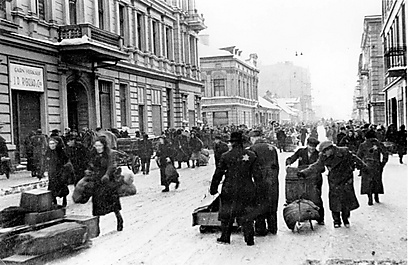The Lodz Ghetto, or Litzmannstadt Ghetto as the Germans renamed it, came into existence in late 1939 and was intended to be a collection point for Jews awaiting deportation. By October 1940, Lodz was meant to be “Judenfrei” (free of Jews) but by that time, the ghetto had become a major industrial and manufacturing centre for both Germany and the German army. Despite ongoing Nazi plans to liquidate the ghetto, it survived until August 1944 because of its productivity and importance to the German war effort. By the time the Lodz liquidation finally took place, it is estimated that over 200,000 Jews had passed through the ghetto, with many sent to the extermination camp at Chelmno and others to Auschwitz. Of the 200,000, it is estimated that only 10,000 survived the Lodz Ghetto.
Now, over seventy years after the Nazi liquidation, a diary has surfaced written by German officers and describing in detail the everyday events within the ghetto. The diary, while avoiding graphic descriptions of so-called “punishments”, is nonetheless a disturbing insight into the suffering of those unfortunate Jews trapped in Lodz. Many Jews had their possessions confiscated and were deprived of their businesses. Wearing a yellow badge was compulsory for all Jews over six years of age, and failure to comply was punishable by death. All Jews were relocated to a specific area in the Old City, and by May of 1940, this area was sealed off from the rest of the city with wire and wooden fences. The Lodz Ghetto came into existence. Jews leaving the ghetto without permission could be shot on sight.
Within the ghetto, order was maintained by a German appointed Jewish Council, the Judenrat. In turn, the Judenrat under the control of Mordechai Chaim Rumkowski created a Jewish police force to enforce German regulations. Trying to escape was a capital offence. Commercial dealings between Jews and non-Jews could result in imprisonment, beatings, deportation to a labor camp and possibly execution. Rumkowski had full authorization to take any necessary measures to maintain order, the Shalom Life reports.
The newly discovered Nazi diary describes how the Lodz Jews were beaten for minor transgressions and how torture was a regular feature of interrogations. There are accounts of Jews being arrested for the possession of “prohibited items”, such as leather and textiles. One such entry details the arrest of “the Jew Goldberg Meyer” for pretending to be Polish and trading textiles. Another diary entry describes German interrogations of Judenrat members from whom they extracted information regarding Jews who were breaking the rules.
Other entries in the diary give detailed reports about prisoners and the ongoing hunt for Jews. One section deals with the hunt for what the Germans describe as a “mischling” (crossbreed in English) who was on the run.
There is also a detailed account concerning the Yaeger family who had tried to hide a young Jewish boy in their home. Following a tip-off, the family was harassed by the Germans until finally they fled. After a manhunt, both the Yaegers and the boy were caught and taken into custody. The entry ends with the ominous statement that a unit would be dispatched to seize their property.
The diary provides a disturbing view of life for Jews trapped in the Lodz Ghetto, as well as offering insight into the way their German overlords felt about and dealt with them. It describes the use of violence, intimidation and fear used by the Nazis to maintain control and to serve the German war machine.
The liquidation of the ghetto began in the summer of 1944. Between June and July that year, 7,000 Jews were sent to Chelmno extermination camp where they perished. When Chelmno was dismantled due to the advance of the Soviet army, those Jews remaining were dispatched to Auschwitz. When the Russians finally reached Lodz on the 19th January 1945, only 877 survivors remained in the Lodz Ghetto.
